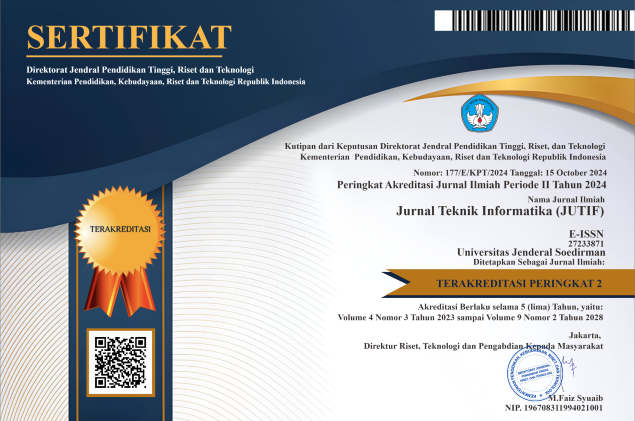Enhancing Malware Detection in IoT Networks using Ensemble Learning on IoT-23 Dataset
DOI:
https://doi.org/10.52436/1.jutif.2025.6.4.4782Keywords:
Ensemble Learning, IoT-23, MalwareAbstract
The Internet of Things (IoT) has become a technological innovation that brings many benefits in various sectors, but also presents challenges, especially in terms of cybersecurity. One of the main threats is malware, which can damage devices, steal data, and disrupt system performance. With the increasing use of IoT, malware attacks on IoT devices are a serious concern. Previous research shows that malware detection models in IoT devices still have shortcomings, especially in terms of accuracy. One of the algorithms used in malware detection, Naïve Bayes, has been shown to provide low accuracy results. This study aims to improve the accuracy of malware detection on IoT networks by applying Ensemble learning techniques using traffic data from the IoT-23 dataset. The methodology used refers to the CRISP-DM (Cross Industry Standard Process for Data Mining) framework, which includes the stages of domain understanding, data understanding, data preparation, modelling, evaluation, and deployment. The results show that Ensemble learning improved the performance of individual models. Naïve Bayes as a single model produces an accuracy of 0.24, increasing to 0.35 when combined with AdaBoost, and 0.99 when combined with XGBoost. The combination of the three models also produced an accuracy of 0.99. These results demonstrate the effectiveness of ensemble learning in improving malware detection accuracy in IoT environments.
Downloads
References
R. Chiwariro and L. Pullagura, “Malware Detection and Classification Using Machine Learning Algorithms,” Int. J. Res. Appl. Sci. Eng. Technol., vol. 11, no. 8, pp. 1727–1738, 2023, doi: 10.22214/ijraset.2023.55255.
Sharipuddin, R. S. Putra, M. F. Aulia, S. A. Maulana, and P. A. Jusia, “Android Security: Malware Detection with Convolutional Neural Network and Feature Analysis,” Media J. Gen. Comput. Sci., vol. 1, no. 1, pp. 7–13, 2023, doi: 10.62205/mjgcs.v1i1.7.
D. Arianyah and I. V. Paputungan, “Jurnal Sains, Nalar, dan Aplikasi Teknologi Informasi,” J. Sains, Nalar, dan Apl. Teknol. Inf., vol. 3, no. 2, pp. 50–57, 2024, doi: 10.20885/snati.v4.i1.1.
N. A. Stoian, “Machine Learning for Anomaly Detection in IoT networks: Malware analysis on the IoT-23 Data set,” Univ. Twente, 2020.
Y. Pristyanto, “Penerapan Metode Ensemble Untuk Meningkatkan Kinerja Algoritme Klasifikasi Pada Imbalanced Dataset,” J. Teknoinfo, vol. 13, no. 1, p. 11, 2019, doi: 10.33365/jti.v13i1.184.
M. A. Hama Saeed, “Malware in Computer Systems: Problems and Solutions,” IJID (International J. Informatics Dev., vol. 9, no. 1, p. 1, 2020, doi: 10.14421/ijid.2020.09101.
M. N. Alenezi, H. Alabdulrazzaq, A. A. Alshaher, and M. M. Alkharang, “Evolution of Malware Threats and Techniques: A Review,” Int. J. Commun. Networks Inf. Secur., vol. 12, no. 3, pp. 326–337, 2020, doi: 10.17762/ijcnis.v12i3.4723.
T. A. Cahyanto, V. Wahanggara, and D. Ramadana, “Analisis dan Deteksi Malware Menggunakan Metode Malware Analisis Dinamis dan Malware Analisis Statis,” J. Sist. Teknol. Inf. Indones., vol. 2, no. 1, pp. 19–30, 2017.
D. Vijayanand and R. K. Singh, “Guardians of IoT : Malware Analysis of IoT Devices Using Machine Learning,” vol. 45, no. 1, pp. 911–924, 2024.
N. Abdalgawad, A. Sajun, Y. Kaddoura, I. A. Zualkernan, and F. Aloul, “Generative Deep Learning to Detect Cyberattacks for the IoT-23 Dataset,” IEEE Access, vol. 10, pp. 6430–6441, 2022, doi: 10.1109/ACCESS.2021.3140015.
L. M. Cendani and A. Wibowo, “Perbandingan Metode Ensemble Learning pada Klasifikasi Penyakit Diabetes,” J. Masy. Inform., vol. 13, no. 1, pp. 33–44, 2022, doi: 10.14710/jmasif.13.1.42912.
N. Chatrina Siregar, R. Ruli, A. Siregar, ; M Yoga, and D. Sudirman, “Implementasi Metode Naive Bayes Classifier (NBC) Pada Komentar Warga Sekolah Mengenai Pelaksanaan Pembelajaran Jarak Jauh (PJJ),” J. Teknol. Aliansi Perguru. Tinggi BUMN, vol. 3, no. 1, pp. 102–110, 2020.
E. Martantoh and N. Yanih, “Implementasi Metode Naïve Bayes Untuk Klasifikasi Karakteristik Kepribadiaan Siswa Di Sekolah MTS Darussa’adah Menggunakan Php Mysql,” J. Teknol. Sist. Inf., vol. 3, no. 2, pp. 166–175, 2022, doi: 10.35957/jtsi.v3i2.2896.
L. Pebrianti, F. Aulia, H. Nisa, and K. Saputra S, “Implementation of the Adaboost Method to Optimize the Classification of Diabetes Diseases with the Naïve Bayes Algorithm,” J. Sist. dan Teknol. Inf., vol. 7, no. 2, pp. 122–127, 2022, [Online]. Available: http://jurnal.unmuhjember.ac.id/index.php/JUSTINDO
A. A. Azmee, P. P. Choudhury, A. Md. Alam, O. Dutta, and M. I. Hossai, “Performance analysis of machine learning classifiers for detecting PE Malware,” Int. J. Adv. Comput. Sci. Appl., vol. 11, no. 1, pp. 510–517, 2020, doi: 10.14569/ijacsa.2020.0110163.
E. V. Tjahjadi and B. Santoso, “Klasifikasi Malware Menggunakan Teknik Machine Learning,” J. Ilm. Ilmu Komput., vol. 2, no. 1, pp. 60–70, 2023.
Ari Sandriana, Rianto, and Firmansyah Maulana, “Klasifikasi serangan Malware terhadap Lalu Lintas Jaringan Internet of Things menggunakan Algoritma K-Nearest Neighbour (K-NN),” E-JOINT (Electronica Electr. J. Innov. Technol., vol. 3, no. 1, pp. 12–22, 2022, doi: 10.35970/e-joint.v3i1.1559.
M. Ihsan, R. K. Niswatin, and D. Swanjaya, “Deteksi Ekspresi Wajah Menggunakan Tensorflow,” Joutica, vol. 6, no. 1, p. 428, 2021, doi: 10.30736/jti.v6i1.554.
H. Asyraf and M. E. Prasetya, “Implementasi Metode CRISP DM dan Algoritma Decision Tree Untuk Strategi Produksi Kerajinan Tangan pada UMKM A,” J. Media Inform. Budidarma, vol. 8, no. 1, p. 94, 2024, doi: 10.30865/mib.v8i1.7050.
F. Abdusyukur, “Penerapan Algoritma Support Vector Machine (Svm) Untuk Klasifikasi Pencemaran Nama Baik Di Media Sosial Twitter,” Komputa J. Ilm. Komput. dan Inform., vol. 12, no. 1, pp. 73–82, 2023, doi: 10.34010/komputa.v12i1.9418.
I. J. Fadillah and C. D. Puspita, “Pemanfaatan Metode Weighted K-Nearest Neighbor Imputation (Weighted Knni) Untuk Mengatasi Missing Data,” Semin. Nas. Off. Stat., vol. 2020, no. 1, pp. 511–518, 2021, doi: 10.34123/semnasoffstat.v2020i1.409.
A. S. Arifianto, K. D. Safitri, K. Agustianto, and I. G. Wiryawan, “PENGARUH PREDIKSI MISSING VALUE PADA THE EFFECT OF MISSING VALUE PREDICTION ON,” vol. 9, no. 4, pp. 779–786, 2022, doi: 10.25126/jtiik.202294778.
N. Hanifah, M. Irwan, and P. Nasution, “Manajemen Data Yang Efektif : Solusi Untuk Mencegah dan Mengatasi Duplikasi Data Dalam Perusahaan,” vol. 3, no. 1, 2025.
Y. E. Ardiningtyas, P. Heruningsih, and P. Rosa, “Analisis Balancing Data Untuk Meningkatkan Akurasi Dalam Klasifikasi,” Pros. Semin. Nas. Apl. Sains Teknol. 2021 , vol. 2021, no. Prosiding SNAST 2021, pp. A24–A28, 2021.
O. Somantri, W. E. Nugroho, and A. R. Supriyono, “Penerapan Feature Selection Pada Algoritma Decision Tree Untuk Menentukan Pola Rekomendasi Dini Konseling Oman,” J. Sist. Komput. dan Inform., vol. 4, no. 2, pp. 272–279, 2022, doi: 10.30865/json.v4i2.5345.
H. M. Lumbantobing, R. A. Marcellino, and I. C. Bu’ulolo, “Penerapan Metode Feature Selection pada Algoritma Naïve Bayes dalam Kasus Keyword Extraction,” Citee, pp. 117–123, 2020.
N. Al Sarah, F. Y. Rifat, M. S. Hossain, and H. S. Narman, “An Efficient Android Malware Prediction Using Ensemble machine learning algorithms,” Procedia Comput. Sci., vol. 191, no. 2019, pp. 184–191, 2021, doi: 10.1016/j.procs.2021.07.023.
Additional Files
Published
How to Cite
Issue
Section
License
Copyright (c) 2025 Kurnia Anggriani, Syakira Az Zahra, Agus Susanto

This work is licensed under a Creative Commons Attribution 4.0 International License.



























